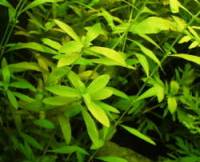|
|
Aquarium Plants
|
Aquatic plants perform a number of functions in the aquarium. They oxygenate the water and contribute
to maintaining a balanced water chemistry. They serve as an additional site for colonisation by
bacteria and may even help to seed new tanks with the beneficial bacteria required to break down waste
products. However, plants are probably more often added because they enhance the look of the tank, while
providing a refuge for fish. Well planted aquariums are a stunning sight.
|
|
To grow plants successfully in the aquarium, you need to balance the amount of
lighting with nutrient levels. Standard aquarium hoods often have only a single tube and this may
not be adequate for most plants. If the light is increased, however, you may need to use a fertilizer or
nutrient supplement and possibly CO2 addition to keep plant growth vigorous and avoid excessive algae.
|
 |
|
It is unnecessary to leave lighting on for more than 12 hours a day - longer periods are likely to favour
algal growth, rather than promote plant growth. Consider adding algae eating fish if appropriate to the
setup, Otocinclus species are particularly suited to smaller planted tanks, as they will not
damage leaves.
|
|
When planting a new tank, it is advisable to add all of the plants at the start, so that they become
established before algae has a chance to utilise any excess light and nutrients. Include some quick
growing plants in the initial stages. Floating plants are useful if you wish to shade part of the
aquarium which will be left unplanted (or contain low-light plants), catfish and some others will
appreciate an area away from the glare of the main lights.
|
Outlined below are a few basic plant care tips.
- Before planting, remove any decaying or yellowed leaves. Decaying leaves are a drain on the plants nutrient
supply.
- Remove any dying roots, as these will rot in the substrate. These will appear limp and brown, healthy
roots are normally pale and more rigid.
- For stem plants, remove the bottom few leaves. These will receive little light and a new cutting
will not have an adequate root system to support a full complement of leaves.
- Tubers should be planted at an angle in the substrate, with the growing tip exposed.
- Some plants require attachment to rocks or bogwood to thrive, rather than planting in the substrate,
these include Java Fern and Java Moss.
- Cuttings can be made from stem plants once they reach the surface. These can be replanted in the
substrate and will soon grow a new root system.
- Many plants reproduce using runners. The new plants can be separated from the parent plant once they
have established themselves, when they reach about one-third of the size of the original plant.
Now online: A mini-directory of some of the more popular aquatic plants and their needs!
[Home]
[Article Library]
[Fish Index]
[Tank Setups]
[Forum]
[Site Map]
|
|
|



